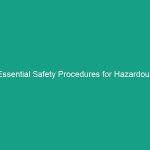Introduction
Good morning team! Today, we’re going to dive into a crucial topic that impacts our daily operations and overall Safety: hose Safety. As many of you know, hoses are common tools in various industries, from construction to manufacturing, but they can also pose significant Hazards if not handled correctly. Understanding how to work safely with hoses not only protects you but also your colleagues and the Environment we operate in. Let’s explore why hose safety is vital and how we can avoid critical risks at work.
Understanding Hose Safety
Hose safety refers to the practices and protocols necessary to prevent accidents and injuries related to the use of hoses in the workplace. Hoses are often used for transporting fluids under pressure, which can lead to serious injuries if they fail or are misused. Understanding hose safety is essential because it directly affects your health and safety, as well as the efficiency of our operations.
Common misconceptions include the belief that all hoses are created equal or that they don’t require regular inspections. In reality, hoses have specific ratings, and their condition can greatly affect their performance and safety. Therefore, it’s important to treat hose safety with the seriousness it deserves.
Key Hazards, Risks, and Safety Considerations
Using hoses comes with inherent risks. Here are some of the key hazards associated with hose usage:
- Hose Failure: Burst hoses can cause serious injuries due to high-pressure fluids.
- Improper Connection: Leaks can occur if hoses are not properly connected, leading to slip hazards or chemical exposure.
- Inadequate Training: Employees unfamiliar with hose Operation may misuse equipment, increasing the likelihood of accidents.
- Environmental Factors: Extreme temperatures or chemicals can deteriorate hose material, leading to failures.
Ignoring hose safety practices can have real-world consequences, including personal injuries, equipment damage, and even environmental contamination. It’s essential to recognize these risks and take proactive measures to mitigate them.
Best Practices, Procedures, & Actionable Advice
Now that we understand the risks, let’s discuss some Best Practices for hose safety:
1. Regular Inspections
Always inspect hoses before use. Look for signs of wear and tear such as cracks, bulges, or cuts. Check fittings to ensure they are secure and not corroded. If you notice any defects, remove the hose from service immediately.
2. Proper Handling Techniques
When handling hoses, avoid dragging them across rough surfaces, as this can cause damage. Use hose reels or hangers to store hoses when not in use. This helps prevent kinks and abrasions.
3. Use the Right Hose for the Job
Ensure you’re using hoses rated for the specific pressure and type of fluid you are working with. Consult the manufacturer’s specifications to confirm that the hose meets the required Standards.
4. Training and Awareness
Participate in regular training sessions on hose safety. Make sure all team members are educated about the proper use, maintenance, and storage of hoses. This will ensure everyone is aware of potential hazards and knows how to respond to incidents.
5. Emergency Procedures
Know the emergency procedures in case of hose failure or leaks. Ensure that everyone knows where to find emergency shut-off valves and how to use them. Regularly practice emergency drills to keep safety protocols fresh in everyone’s mind.
Real-World Case Study
Consider a recent incident at a neighboring facility where a high-pressure hose burst due to improper handling. Fortunately, the workers had undergone adequate training and were able to shut down the equipment quickly, minimizing injuries and damage. This incident highlights the importance of following safety protocols.
Regulations, Standards, and Compliance
Compliance with safety standards is crucial to ensuring Workplace Safety. Key Regulations include:
- OSHA Standards: The Occupational Safety and Health Administration outlines specific requirements for hose inspection and use.
- ISO Standards: The International Organization for Standardization provides guidelines on hose safety and material specifications.
Adhering to these regulations helps protect employees and the company from legal liabilities while promoting a culture of safety. It’s important to stay updated on changes in regulations and to ensure compliance throughout our operations.
Employee Engagement & Discussion
Now that we’ve covered the essential hose safety tips, let’s engage in a discussion. Here are a few questions to consider:
- What safety challenges have you encountered related to hose usage?
- Can anyone share an experience where following hose safety protocols made a difference?
- How can we improve our current hose safety practices?
Your insights are invaluable, and sharing experiences can help us all learn and grow in our safety practices.
Conclusion & Key Takeaways
In summary, hose safety is a critical aspect of our workplace that must not be overlooked. By regularly inspecting hoses, using proper handling techniques, ensuring adequate training, and adhering to compliance standards, we can significantly reduce the risks associated with hose usage.
Remember, safety is a shared responsibility, and each of us plays a vital role in maintaining a safe work environment. Thank you all for your attention today, and let’s commit to prioritizing safety in all our daily operations. Together, we can create a safer workplace for everyone!


